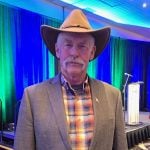The possible link between a Canadian farm and the first case of BSE discovered in the United States should have little bearing on health and border regulations, according to officials.
“From a scientific point of view we don’t see what has happened should change any of the scientific issues regardless of what side of the border this animal was born on,” said Dennis Laycraft, executive vice-president of the Canadian Cattlemen’s Association.
However, he said it was reasonable for Americans to hold back until their investigation is complete. The major part of Canada’s investigation took about three weeks.
Read Also

Lending policy still focused on primary producers: Farm Credit Canada
Farm Credit Canada said it has not changed its business practices and remains committed to supporting all producers, after a report from an Ottawa-based media outlet claimed otherwise.
Ron DeHaven, chief veterinarian for the U.S. Department of Agriculture said its investigation shows 82 cattle entered the U.S. through Oroville, Washington on Sept. 4, 2001. The BSE-positive cow at a Mattawa, Wash., dairy farm may have been in that group.
His investigators are looking for the cows and their offspring.
“I want to reiterate that our interest in finding these cows is not because BSE can spread from cow to cow but because it’s possible that they may have shared a common feed source when they were young, and therefore potentially would have had a common exposure,” said DeHaven.
DNA test results conducted at laboratories in Saskatchewan and Nebraska should determine the location of the birth herd of the animal. Results are expected Jan. 7. There was no word at press time.
In the U.S., three dairy herds were quarantined and investigators were looking for a group of 82 animals listed on a Canadian animal health certificate shipped to Washington state. The group may include the BSE infected animal. The Canadian Food Inspection Agency was involved in the investigation.
DeHaven also announced 450 bull calves from the farm where BSE was found were to be slaughtered and tested.
The positive cow gave birth to a bull calf at the beginning of December. She went down after delivering the calf and could not rise so the farm owners shipped her for slaughter.
While there was almost no live trade over the Christmas break, there was concern the case could cause another market crash similar to what happened after last May’s BSE announcement in Canada.
As events of the American BSE case unfolded, they carried a sense of déjˆ vu for Canadian producers.
While daily updates have worried Canadian producers about a longer border closure to their cattle, new U.S. rules for handling beef byproducts and downer animals may be a positive development because they are in line with regulations here.
On Dec. 30, U.S. agriculture secretary Ann Veneman announced increased BSE testing and prohibitions on the same specified risk materials as Canada.
Animals unable to walk on or off a truck for any reason will not be accepted for slaughter.
“From a harmonization perspective it makes things easier from a rule making perspective,” said Laycraft.
On Jan. 2, the Animal and Plant Health Inspection Service division of the U.S. Department of Agriculture said a comment period on a proposal for allowing live cattle and bone-in beef to be imported from Canada would close Jan. 5 as scheduled.
The agency said it is unknown when a decision on the rule will be made and it may require more information before resuming live trade.
Alberta premier Ralph Klein said Dec. 29 his government will not abandon producers but he refused to speculate on potential losses.
It is estimated the Alberta BSE case cost the Canadian industry nearly $2 billion in lost sales and depressed markets.
“We haven’t examined it yet. It is too early to talk about aid programs because the investigation is not done,” Klein said.
“We will stand by our farmers.”















